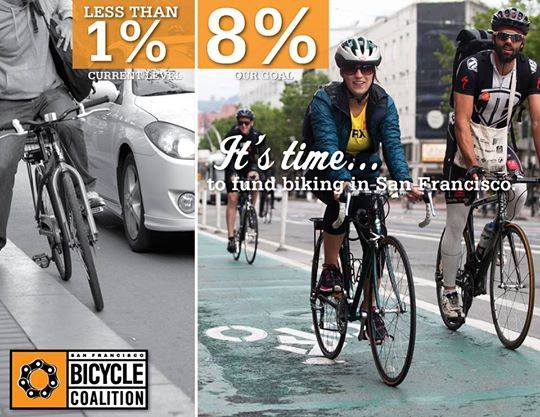Bike and pedestrian advocates are pushing the SFMTA to make more room in its budget for safety projects and programs as the agency's board of directors weighs its priorities.
Bike/ped funds currently make up less than 1 percent of the SFMTA's operating and capital budgets; the vast majority goes towards Muni. And although the agency has professed its commitment to Vision Zero, as well as its Bicycle Strategy and the WalkFirst plan that lay out the map to safer streets, funds for street safety are competing with other funding pushes. Yesterday's SFMTA Board meeting was packed with dozens of commenters calling for the expansion of free Muni pass programs to low-income seniors, people with disabilities, and extending the youth program to 18-year olds.
Leah Shahum, executive director of the SF Bicycle Coalition, pointed out that "there is not a more affordable option than" walking and biking, and urged the board to "include [those] in the equity lens."
The SFBC and Walk SF have highlighted that the SFMTA's operating budget devotes more money to office supplies, over $5 million, than to bike and pedestrian safety programs, which each get about $3 to $5 million.
Shahum pointed out that the proposed SFMTA budget calls for 1.9 new miles of bike lanes, and 4.5 miles of upgraded bike lanes, per year. The middle of the three scenarios laid out in the SFMTA's Bicycle Strategy calls for upgrades to 10 new miles of bike lanes each year.
Bike and pedestrian funding are poised to get only a slight increase in the share of the SFMTA's existing revenues in the next budget [PDF]. The agency is banking on three proposed funding measures headed to the ballot this November that altogether could provide about half the funds needed for WalkFirst and the "medium" Bicycle Strategy scenario.
"We did work to find ways to put more revenues in here, although we don't have a whole lot of flexibility there," said SFMTA Director Ed Reiskin. "You could argue it's never enough, but it's a significant investment we'll be making."
SFMTA Board Vice Chair Cheryl Brinkman asked Reiskin to address the comparisons between bike/ped funding and office supplies at a later meeting. "I know it's a great rallying cry... safety is our number one goal, but I'd like to know where that number comes from. Hopefully it's not true that we spend more on paper than we do on bicycle safety."
"We can't meet our bike and pedestrian mode shift goals without increasing safety, and we can't meet our transit demand without including our bicycle and pedestrian mode shift goals," she added.
The SFMTA will continue to drill down the details of its two-year budget next budget at a hearing on April 15.
"I'm very worried about what happens in November," said Brinkman. "Do we have a plan B to improve the safety of our streets if we're not successful?"






